The deeper I dig into this love of panfishing, the more I am beginning to enjoy what comes after a fishing trip then the actual trip. Sure I still lose sleep the night before I know I'll be either on, in, or next to the water with a fishing rod in hand; there's always an anticipation while enroute to the destination, and having a sudden tug or seeing a float disappear still puts a smile on my face.
This recent foray into the unknown has really focused my attention away from the angling and more toward the diagnosis of both my own abilities and the ability of the fishery.
Follow me for a few minutes and I'll show you why I say this.
Sunday afternoon, ZZ and myself had a planned return trip to the Saginaw area below Brunner's Island on the Susquehanna River. I have been on a mission of sorts to see what kind of bluegill fishery this flow had. I hadn't had the results I was hoping for, yet there was just enough being seen to fuel more field research.
As we turned onto Gut Rd. we immediately noticed the drive wasn't going to be a fast one. The road was a sheet of thick ice.
There were more angler's along this stretch of water then I had seen all year, and the parking area at the railroad bridge was overflowing with vehicles.
I opted to continue down the "path" to the lower boat launch - planning to fish our way upstream. The lower parking opportunities were no better then the first lot, so I backed the truck into a small hole off the path halfway between each lot.
The whole area was full of anglers. Some were chest deep in water, others had lawn chairs set up right beside the water enjoying the afternoon.
ZZ and I turned and headed down river.
The water was exceptionaly clear, and with polarized glasses I was able to see everything from the elevated shoreline. The first hole we came to held a small collection of carp, and a submerged tree trunk with a lone branch sticking off it. I didn't see any fish holding around it, but couldn't resist unhooking my rig to present a jig along its' length.
I was rigged with a 1/32oz. hair jig set 24" under a pegged float. (There's a little more detail behind the actual rigging, but we'll get to that a little later.) The idea was to let the current move the jig along as if it was a baitfish being swept by the current. Numerous passes in this pool produced nothing quickly so we continued to walk downstream, peering into the water as we went.
The next stop was another blind chance spot. I had noticed a flow break along an otherwise smooth section of water. As we got closer, I could see it was a piece of driftwood that had gotten wedged on the bottom. What interested me was the washed out area this wood created just below it. It was just deep enough I couldn't make out the bottom. ZZ still hadn't made a cast, and the height of the shoreline combined with the melting snow made me a bit uneasy to allow him much closer then where he was behind me. I took him to an open area downstream that allowed clear casting and the tail end of this "divot" to fish. He was rigged with a 1/64oz. jighead tipped w/a Honey Worm set to suspend 22" below a slip float.
I walked back upstream to float past the driftwood.
The intial cast landed on target about three feet above the rippled surface, allowing the jig to be at set depth just as it entered the washout area.................the float hesitated. I reared back and missed.
A repeat cast of the first was rewarded this time with the float popping under the surface. I reared, felt the weight of a fish...............and promptly lost it.
A deep breathe was taken before I placed another drift into motion. This time I was ready. The float never made it past the wood - the float completely disappeared, I waited a second, then lifted the rod straight up.........................fish on!
I could see right away as the fish came up to the surface it was a small panfish, but I wasn't prepared for what I was about to see.
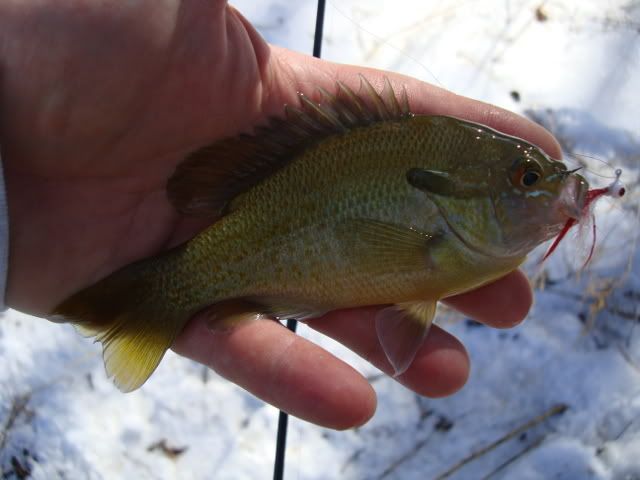
When I first saw the gillflap angle, length, and lack of bright orange on the breast, the redbreasted sunfish wasn't one of my guesses. Thinking I had a real gem in my presence, I quickly took a picture and released the fish. I must have been speaking my thoughts out loud, as ZZ appeared at my side scolding me for letting it go before he could see it.
We spent a considerable amount of time here; I was hoping for a repeat, and it looked like the spot held potential for other sunfish. It wasn't to be.
Moving farther downstream, we came to a large pool off the main flow of the river. Here again, I could see every rock and pebble.
There were no fish to be seen, but I set ZZ up to fish an area, while I postioned myself to fish another section.
I set up from an elevated location so I could keep an eye for any movement within the pool. My first cast didn't drift 3 ft. before I saw the white head of the jig disappear. I never did look at the float, but instinctively pulled up on the rod. The fish did not approve of this action, as it rolled sideways giving me an eyefull of silver flashes then took off across the pool. I know I was smiling as it put up a fight, but even more when I had it in my hand.
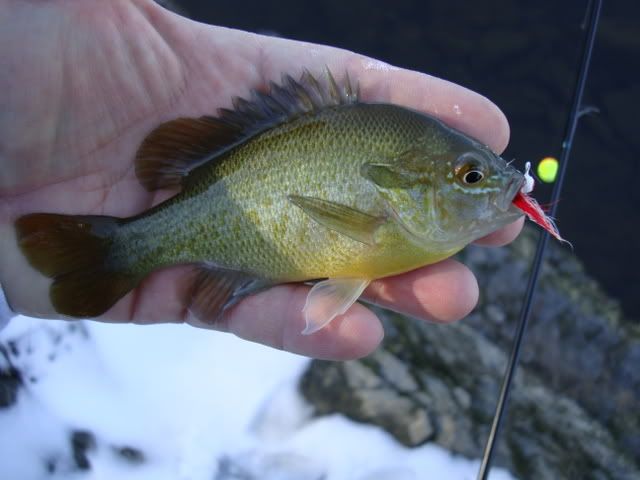
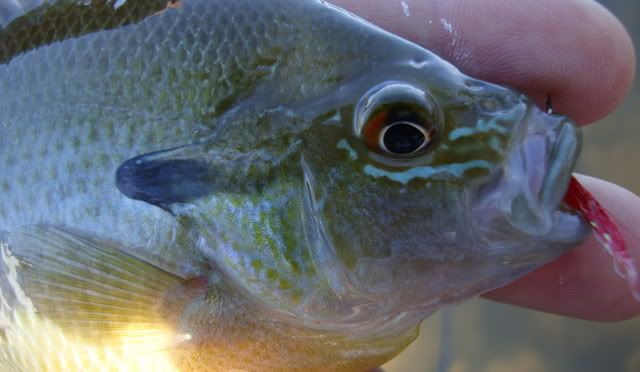
Originally thinking I was handling longear sunfish - which are an endangered species in Pa - I was quite taken by their appearance. Looking back at the pictures, I realized these are redbreasted sunfish and not longears. By this point in time, my trip had reached it's pinnicle. How could it possibly get any better?
More casts throughout the pool did just that - made it better. The fish were slowly getting bigger:
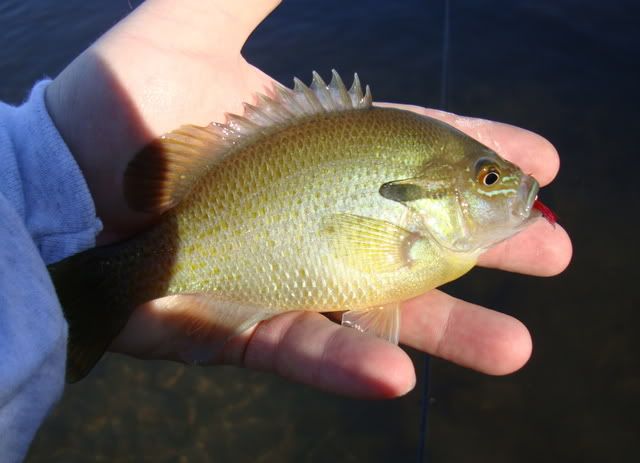
ZZ had yet to get a hit.
It was getting closer to kick-off, and I noticed we suddenly had the area to ourselves. We packed up and headed upstream to see if we could get into the area I had originally wanted to fish. The move paid off, as there was only one vehicle left when we reached the area we started in................my truck.
The sun had dropped down below the treeline now, making the spot and fish technique I was using less then ideal. We came to the backside of a large blowdown that looked as if it just had to hold some panfish. I placed the float farther back from the tree then I wanted, but immediately saw the swarm of fish competing for a bite of my jig. As quickly as I saw them, I was hooked up.....................and I knew when I saw it turn it's side against the resistance of the rod I was into a good bluegill.
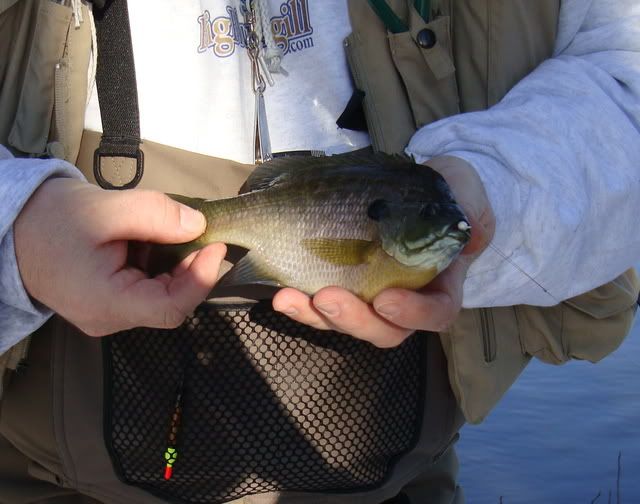
We had found what we had been looking for - fish that had "the helmet."
After a picture and a few more moments of admiration, it was released and I turned my attention to ZZ. He took the spot for best presentation, and placed his Honey worm right where it needed to be. We watched his float intently...................waiting....................waiting................nothing doing.
Another great placement............................and more nothing.
A third cast that went slightly off target, but still well within the range I witnessed the fish willing to move around in.....................................nadda.
I picked up my rod, set the hair jig right against the tree, in the flow, and no sooner did it touch down - it disappeared. Add another oversized gill to the count.
I had ZZ put the Honey Worm back in again, and nothing.
I wasted no time changing him over to a 1/32oz. hair jig. This is what the doctor ordered, as now he was into fish on nearly every cast. Once I picked up my rod again, the doubles started and we began comparing who had the biggest ones. It was a fun time.
Before we left I wanted to hit one more spot, so we left these fish only to find another collection of 'gills upstream farther.
The new location supplied us with yet another species - the green sunfish:
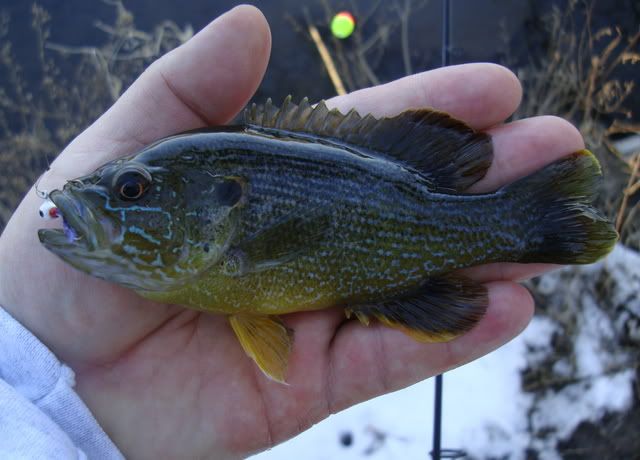
I noticed as it grew darker, the fish changed how they reacted to the presentation. Rather then a slow drift next to cover, it appeared as if the larger fish had moved away from the cover and wanted a pull-stop-pull presentation with the floats. It worked like a charm. ZZ had it down to a science, so I turned to the logjam I was standing next to and changed gears from a cast/retrieve to a dabble. I stuck the 6'6" rod I was using as far out as I could, and dropped the jig-n-float into a small opening deep in the jam.
I'm pretty sure the jig was taken before the float ever touched the surface, because it certainly didn't stop once it hit the water.
I missed what ever it was.
Not to be beaten, I copied the presentation. The reward came in the form of a repeat performance from my dance partner:
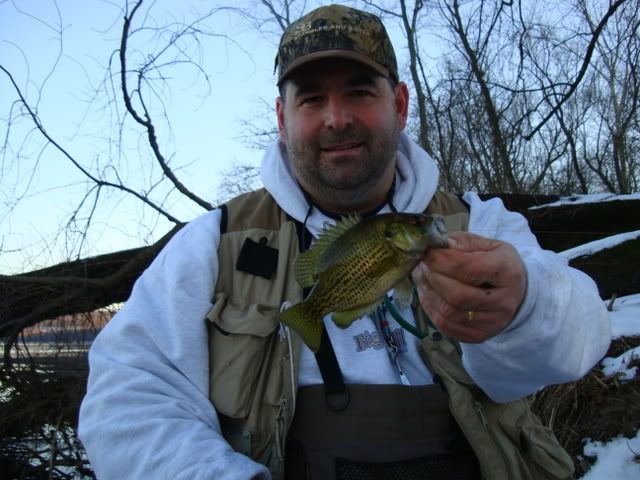
HA! It was the icing on the cake. I wanted to find big bluegill; I found not only them, but also a few cousins. I wanted to get into some rockbass, and there was a whole mess of them underneath the logjam I was standing next to.
ZZ was having a blast; it just couldn't get any better.
Or could it?
When we finally decided to pull the plug, I looked at the counter I was hitting in my pocket during this trip. It was settled on the number 44.
I looked at the stringer of fish I purposely kept to start a running documentation of facts from this waterway. It held 5 fish - (4) bluegill and (1) rockbass. As I turned to head up to the truck, I saw this out of the corner of my eye:
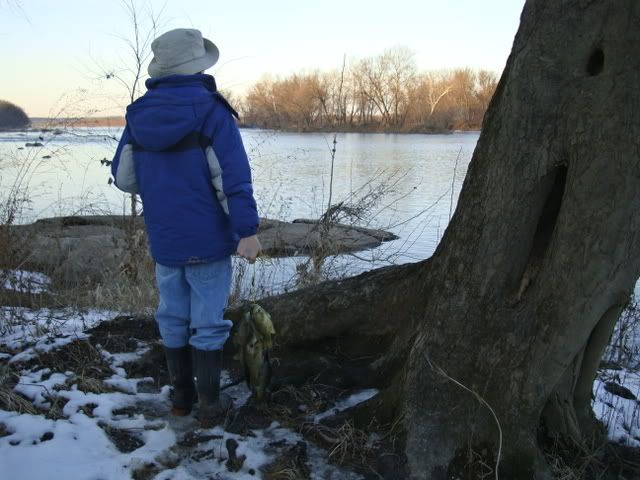
Couldn't help but wonder if I was seeing the future of the sport develop right before my very eyes.
The trip was fun, but the real exciting stuff happened after the football game. Just how big were those fish we were into?
I won't go into great depth with these numbers, as I have something brewing that will only elevate whatever I could do right now. This is the part of the trip that really had me excited.
I took the fish we kept, measured them, weighed them, and aged them. Here's what I found:
Bluegill:
8" - 6.0ozs
8" - 6.2ozs
8.25" - 7.4ozs
7 15/16" - 5.7ozs
Rockbass:
6.75" - 3.3ozs.
I'm still working on getting a firm age class on each of the fish. I've found that the warmwater these fish are living in seems to extend their growth period. Not a single fish had prominent growth markings on either the otoliths or the scales. As of right now, the two 8" fish are between 3.5-4.5 years old.
I took these numbers and compared them with what the Pa management has documented as "averages":
Bluegill:
8" - 4.8oz - 5.5 years
8.25" - 5.6ozs - 6.0 years
It has taken three(3) trips, to find bluegill that can be considered above average from a new-to-me, public waterway. Having Wr numbers from 82 to 98, are there bigger bluegill still elluding us within this flow?
The quest goes on......................








![]()
You need to be a member of Bluegill - Big Bluegill to add comments!
Join Bluegill - Big Bluegill